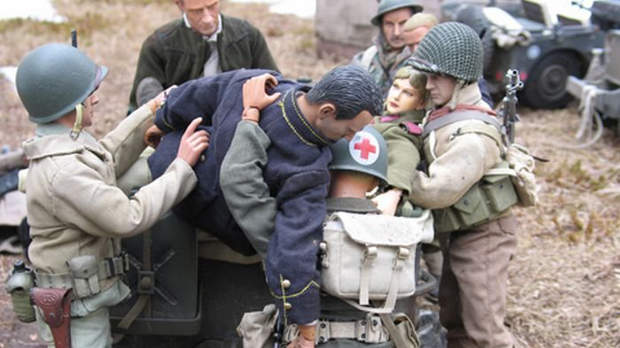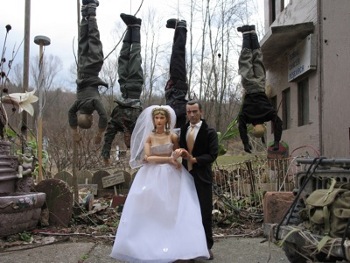 Back to selection
Back to selection
Marwencol’s Jeffrey Malmberg
By Alicia Van Couvering

Mark Hogencamp was an illustrator living in Kingston, NY, and one night in 2000, he walked out of a bar and was followed by a group of teenagers who beat him mercilessly and left him for dead. Hogencamp was in a coma for nine days, suffered massive brain damage, and lost most of his memory and ability to move and write. Unable to afford therapy, he came up with his own: Marwencol. A 1/6 scale World War II-era town set someplace in Belgium, Marwencol’s inhabitants are dolls painstakingly painted and clothed by Mark, most representing a person from his real life. Mark’s doll is our hero, Captain Hogencamp, a strapping GI who first stumbles upon the town when its only other residents are women (Barbies, wearing co-opted SS uniforms from the soldier’s they’ve killed).
Hogencamp used the small dolls and props to redevelop his hand-eye coordination while he dealt with the psychic wounds from his attack through the town’s many battles with the SS and interpersonal dramas. He also began to take photographs of the events as they unfold, which are soon discovered by an art magazine, leading to a gallery show in New York City and a filmmaker, Jeffrey Malmberg, showing up to make a documentary about him. Four years later, Marwencol is premiering at SXSW, and it is a captivating, multi-faceted portrait of Hogencamp and the incredible world he’s created – call it art, therapy, or something in between, you’ve never seen anything like it before. As Hogencamp said to Malmberg the first day of filming, “it just gets weirder and weirder.”
You can view images of Marwencol and read more about the film at marwencol.com.
Filmmaker: I have a superficial question: how physically big is Marwencol? Like 20 x 20 feet?
Malmberg: I would say it’s about maybe twelve buildings at this point. It’s gotten pretty developed — now there’s kind of like a main drag through town, which Mark can walk down. But he’s very careful; he’ll only walk on a certain side so that he doesn’t get big footprints in the photographs. it’s kind of changed in the last four years. The sets stay up forever once he builds them. Though sometimes they change — now Pocketful of Posies is gone, it’s something else, [I think because] Colleen moved away. And then it’ll change again. In Winter, it can get really snowy [in Kingston], and because the bar set is inside his house, the bar becomes the focus of the winter scenes. He’s developed this yearly routine – spring comes, he’ll fix up the buildings, repaint, make a lot of new clothes and uniforms, and in summer he’s like, shoot, shoot, shoot.
Filmmaker: So how did you meet Mark and start the project?
Malmberg: Yeah, been working on it for about four years now. I saw his photographs in Esopus Magazine, and I saw the little captions underneath of like, “Sometimes the soldiers need to get out of town and go to the store two miles away.” It just thrilled me and intrigued me, so I got in touch with Mark, and went out and shot some video of him. He was just learning about the art show, and that became kind of a big thing in his life and mind, so what started as a short became this bigger thing. And then, you know, months turned into years. At this point, I’m glad that it took that long, because it was so much fun to live with Mark through all of these events.
Filmmaker: One of my favorite things about the film is how much more you learn about Mark than you think you’re going to – there are some skeletons in that closet that really take you by surprise, and they are revealed in a very careful progression.
Malmberg: I always think of it as – you know when you go out to dinner with someone you like and you haven’t seen them in a while, and a couple of drinks later, they tell you something really huge. You just think to yourself, “I can’t believe they just told me that.” And we might never talk about it again — you share this one thing at this one moment. I want [the movie] to feel like that, and it was hard to figure out how to do it.
Filmmaker: How did you figure out how to reveal information, in the edit process?
Malmberg: There are a lot of levels to Mark’s world, and I wanted to reveal them in somewhat the same way that I learned them. On the first day, he said to me, “It just gets weirder and weirder.” It really came down to Mark’s world meaning one thing initially and meaning something else in the end. That’s [the structure] that I kept coming back to that just felt right.
Filmmaker: Another informational question: what happened to the boys who beat him up? Did they get convicted? You never address their sentencing in the film.
Malmberg: All five of them got convicted. [I left it out of the film] because there’s been no kind of closure for Mark, so I didn’t want to make it easy for the audience. He still worries about those guys. He still checks the paper every Tuesday to see if they’ve been released. He doesn’t feel like those convictions were appropriate or solved anything for him.
Filmmaker: His feelings about it and fantasies of revenge come out through the violence he creates at Marwencol.
Malmberg: Right, exactly.
Filmmaker: So when you first approached Mark about making a movie, what was his reaction?
Malmberg: I emailed him, and he emailed me back — but I mentioned that I lived in Los Angeles, so in his mind, the fact that I was from “Hollywood” really impressed him! [laughs] So I think that was in my favor. But frankly, I think he was really looking for somebody to talk to at that point, and I just happened to come along. He had a lot of issues that he hadn’t really said out loud. That first interview I did, which is him sitting on the couch, the footage is kind of grainy – it’s almost like he’s waking up from a dream or something.
Filmmaker: It is like he’s channeling his words out of a trance, in that interview.
Malmberg: Totally! And I talked to him about that now, when we watched the completed him, and I think he can really see that too. He’s much more aware now, four years later. There’s a definite difference between shooting him in 2006 and shooting him in 2010. He’s much more articulate. Still always the same smart, brilliant, clever guy, but in terms of his ability to express himself to other people, he’s much more used to talking to other people now.
Filmmaker: Well that’s what’s so interesting about Marwencol itself is that it’s this very private therapeutic tool, but it’s also a way for him to communicate with other people – by putting them into the town as characters.
Malmberg: Yeah, absolutely, I think he enjoys the feedback of people saying, “Oh, what have I been doing in my town lately?” “Oh, you went on a raid with me,” and they’re like, “Wow, that’s cool.” I’ve noticed if somebody tries to suggest things to Mark — like what’s wrong with their character or what their character should be doing – almost immediately that character will be taken down by the SS. [laughs] So it’s like, I’m in the town too, but I know the rules. It’s his world.
It’s also about control, too, you know — he can control this world. I’m realizing more and more how essential it must be to him, because he was an illustrator, [and he lost that ability.]. So he really takes pride when people go, “Oh that looks just like me!” or “Yeah, I totally would do that!” It’s not a joke, it means so much to him. Because he’s trying to represent life in there, or find art in there, you know what I mean? I know he doesn’t think of himself in that way, but he really is an artist.
Filmmaker: Through his gallery show, and you, and the magazine, he is sort of saved by the people who think he is an artist.
Malmberg: We all want to think of this as art, but Mark, the outsider artist, doesn’t even consider it art. He doesn’t get why we want to call it that. A big thing with me while shooting the art show is that I felt like I was telling this story about this guy who is sort of saved through art, and then we went to the show, and it’s wasn’t the story at all. It was just the beginning. [The gallery staff] are all really good people and I think it was a good experience for him, but it was interesting to see him in that environment, [to explore] what we wanted for him versus what he wanted. Frankly, I think he was just kind of bored by it. I remember him saying, “I shot these already, I don’t need to go look at them.”
Filmmaker: That is a central conflict of the film, and outsider art in general – is it good or bad that this very private, possibly very painful work made for private reasons is now artwork on the walls of a gallery for people to judge and maybe even buy.
Malmberg: Well, when he looks at Marwencol and talks about wanting to stay inside it, is that a good or bad thing? Everybody comes at that moment from a different place. Some people say, “Oh my God, it’s perfect for him, it’s never going to stop, and he’s going to get to live there forever,” and then you get the people who say, “Oh my God, that was so sad at the end, he’s never going to finish, he’s never going to get out.” I’m probably 51/49 about it, but mostly I’m just really happy for him.

